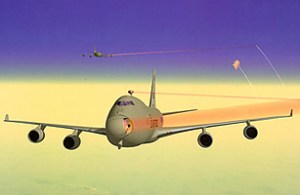It was the late Ted Kennedy who galvanized his fellow Democrats at their 1980 convention by pledging “the work goes on, the cause endures, the hope still lives, and the dream shall never die.” Thirty years later, the Pentagon’s Missile Defense Agency seems to have adopted those stirring words as its own. You may recall the Pentagon’s Airborne Laser program, which has crammed a chemical laser into the belly of a modified 747 aircraft. Earlier this year, it fired a basketball-size beam traveling 670 million m.p.h. (1,078 million km/h) — the speed of light — to destroy a fake enemy missile over the Pacific. “There’s nothing like flaming wreckage” to prove such lasers are not science fiction, an engineer involved in the program said.
But Defense Secretary Robert Gates killed MDA’s Airborne Laser production program last year, scaling it back to a modest research effort. Yet the guys running it have been trying hard to show its merit, so they’ve scheduled more such tests. The next one is designed to double the distance between the 747 and its target to about 100 miles. Unfortunately, they’re not having much luck.
The next shootdown was supposed to take place in early August, “We had a target issue,” Army Lieut. General Patrick O’Reilly, the MDA boss, noted August 17. “It wasn’t even the target, it was the stand that holds the target up, so we didn’t conduct that test.” So they slipped the test to August 15. “We didn’t do it because there was a software module that operates some of our tracking systems,” O’Reilly said of the second attempt, before adding a key caveat: “that do not directly have to do with the laser.” So the engineers rescheduled the test for August 18, but that test was scrapped because of “a problem with the tracking camera cooling system.”
Getting into the swing of things, MDA cancelled the test set for last Sunday before it happened. “A hot bypass valve on the aircraft is in an abnormal condition thus not allowing for proper component cooling,” the agency said. “A new date for the experiment will be set for the upcoming week.” That date was Tuesday, but it had to be canceled “because of unsuccessful tracking beam calibration engagements.” Yet once again there was some good news buried in the terse MDA statement: “The target missile was not launched,” meaning the laser wasn’t tested, meaning the test didn’t fail. And it appears MDA has decided to take a breather, not specifying when the next try will be: “Program officials will determine the next opportunity to conduct the experiment.”
So what, if anything, do these five snafus in a row tell us? First, you’ve got to give credit to an entity that forthrightly acknowledges when things don’t go right. Secondly, it is fair to note that these problems don’t actually appear to involve the laser itself, but all the infrastructure associated with such a complex test, and the desire to learn as much as possible from it. Finally, it should remind us of just how challenging missile development — by either the good or the bad guys — is. Much of the justification for U.S. missile defenses is based on the threat posed by North Korea. As Kim Jong-il travels to China aboard a train that looks like Strelnikov’s from Doctor Zhivago, it’s something to keep in mind.



